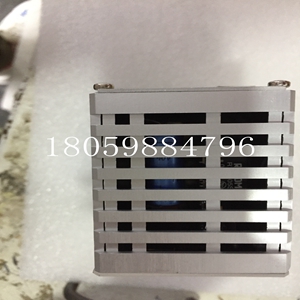3BDZ000398R1工控备件
视频图形适配器上的SVGA端口
由Intel 855GME图形和内存控制器集线器(GMCH)控制。GMCH的硬件和BIOS与支持VESA高分辨率和扩展视频模式的行业SVGA和数字视频标准兼容。表2-2和表2-3显示了模拟监视器的GMCH视频控制器支持的图形视频模式。并非所有SVGA监视器都支持分辨率和刷新率超过640 x 480(85Hz)。不要试图将显示器驱动到超出其能力的分辨率或刷新率。注:在P2背板连接器上使用数字视频时,需要VMIACC-0586/ACC-0586RC或VMIACC-0.590/ACC-0590RC RTM进行图形操作。BIOS中数字视频输出的默认设置为800x600。表2-2支持的Windows 2000图形视频分辨率(模拟)屏幕分辨率最大颜色最大刷新率(Hz)640 x 480 256,所有分辨率都支持High和True。85 768 x 1024 85 800 x 600 85 1024 x 768 85 1024×1280 75 1200 x 1600 60 1280 x 1024 75 1600 x 1200 60表2-3支持的Windows XP图形视频分辨率(模拟)屏幕分辨率最大颜色最大刷新率(Hz)640 x 480 High和True在所有分辨率下均受支持。85 800 x 600 85 1024 x 768 85 1080 x 1280 75 1600 x 1200 60 41视频图形适配器2数字视频接口(DVI)具有数字视频接口,可为独立于显示技术的视频数据类型提供高速数字连接。DVI是响应数字平板显示器的发展而开发的显示接口。
双重转换
在大多数情况下,这些显示器目前连接到模拟视频图形阵列(VGA)接口,因此需要双重转换。来自计算机的数字信号必须转换为模拟VGA接口的模拟信号,然后转换回数字信号,由平板显示器处理。这种固有的低效过程会影响性能和视频质量,并增加成本。相反,当平板显示器连接到数字接口时,不需要数模转换。DVI使用矽映公司的PanelLink,这是一种高速串行接口,它使用过渡最小化差分信号(TMDS)向监视器发送数据。DFP和VESA即插即用接口也使用PanelLink。因此,DVI可以通过使用适配器电缆(取决于适配器的信号质量)与这些以前的接口配合使用。DVI还支持VESA显示数据通道(DDC)和扩展显示标识数据(EDID)规范。DDC是显示器适配器和监视器之间的标准通信信道。EDID是一种标准数据格式,包含监视器信息,如供应商信息、监视器定时、最大图像大小和颜色特性。EDID信息存储在显示器中,并通过DDC进行通信。EDID和DDC使系统、显示器和图形适配器能够通信,以便系统可以配置为支持显示器中可用的特定功能。DVI连接器DVI连接器有24个引脚,可容纳最多两个TMDS链路以及VESA DDC和EDID服务。DVI规范定义了两种类型的连接器(见图1):•DVI Digital(DVI-D)仅支持数字显示器(在上使用)•DVI Integrated(DVI-I)支持数字显示器,并与模拟显示器向后兼容(不支持)VMIVME-8807/VME-7807RC使用DVI-I连接器和单个TMDS链路。DVI-I接口可容纳一个12或24针DVI插头连接器或一种新型模拟插头连接器,该连接器使用四个附加引脚,外加一个接地平面插头,以保持模拟RGB信号的恒定阻抗。
SVGA port on video graphics adapter
Controlled by the Intel 855GME Graphics and Memory Controller Hub (GMCH). GMCH's hardware and BIOS are compatible with industry SVGA and digital video standards that support VESA's high resolution and extended video modes. Table 2-2 and Table 2-3 show the graphic video modes supported by the GMCH video controller of the analog monitor. Not all SVGA monitors support resolutions and refresh rates in excess of 640 x 480 (85Hz). Do not attempt to drive the monitor to a resolution or refresh rate that exceeds its capabilities. Note: When using digital video on P2 backplane connector, VMIACC-0586/ACC-0586RC or VMIACC-0.590/ACC-0590RC RTM is required for graphic operation. The default setting of digital video output in BIOS is 800x600. Table 2-2 Supported Windows 2000 graphics video resolution (analog) Screen resolution Maximum color maximum refresh rate (Hz) 640 x 480 256, all resolutions support High and True. 85 768 x 1024 85 800 x 600 85 1024 x 768 85 1024 × 1280 75 1200 x 1600 60 1280 x 1024 75 1600 x 1200 60 Table 2-3 Supported Windows XP Graphics Video Resolutions (Analog) Screen Resolutions Maximum Color Maximum Refresh Rate (Hz) 640 x 480 High and True are supported at all resolutions. 85 800 x 600 85 1024 x 768 85 1080 x 1280 75 1600 x 1200 60 41 Video Graphics Adapter 2 Digital Video Interface (DVI) has a digital video interface that provides high-speed digital connectivity for video data types independent of display technology. DVI is a display interface developed in response to the development of digital flat panel displays.
Double conversion
In most cases, these monitors are currently connected to an analog video graphics array (VGA) connector and therefore require dual conversion. The digital signal from the computer must be converted to the analog signal of the analog VGA interface, and then converted back to the digital signal for processing by the flat panel display. This inherently inefficient process affects performance and video quality, and increases costs. In contrast, when a flat panel display is connected to a digital interface, digital to analog conversion is not required. DVI uses Silicon Image's PanelLink, a high-speed serial interface that uses Transition Minimization Differential Signaling (TMDS) to send data to the monitor. The DFP and VESA Plug and Play interfaces also use PanelLink. Therefore, DVI can be used with these previous interfaces by using adapter cables (depending on the signal quality of the adapter). DVI also supports VESA Display Data Channel (DDC) and Extended Display Identification Data (EDID) specifications. DDC is the standard communication channel between the display adapter and the monitor. EDID is a standard data format that contains monitor information such as vendor information, monitor timing, maximum image size, and color characteristics. EDID information is stored in the display and communicated through DDC. EDID and DDC enable the system, display, and graphics adapter to communicate so that the system can be configured to support specific functions available in the display. DVI connector The DVI connector has 24 pins and can accommodate up to two TMDS links as well as VESA DDC and EDID services. The DVI specification defines two types of connectors (see Figure 1): • DVI Digital (DVI-D) supports only digital displays (for use on) • DVI Integrated (DVI-I) supports digital displays and is backward compatible with analog displays (not supported) VMIVME-8807/VME-7807RC uses DVI-I connectors and a single TMDS link. The DVI-I interface can accommodate a 12 or 24 pin DVI plug connector or a new analog plug connector that uses four additional pins plus a ground plane plug to maintain a constant impedance of analog RGB signals.








